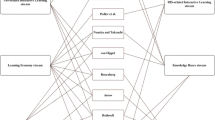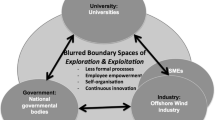Abstract
Research into national innovation systems (NISs) has received extensive academic and policy attention, and is especially relevant with latecomer countries seeking to innovate in challenging industrial environments. In playing catch up with their early industrializing counterparts, methods of learning take on increased importance in determining industrial success for latecomers. The wind turbine technology innovation system is one that is highly dependent on both the extent of the national learning processes and the strength of the national social-institutional setting. This research investigates the case of Taiwan, a country which has embarked on a program to build its national innovative capacity in wind turbine technologies with specific emphasis on Taiwan’s social sector. Within this system, the spotlight will be on four types of learning processes that interplay during wind turbine development: learning by searching, learning by doing, learning by using, and learning by interacting. Through a case study of the emergence of Taiwan’s burgeoning large-scale wind power technology initiatives, the paper aims to add to the understanding on how methods of learning impact upon the success of innovation systems. The findings show that the industry’s future prospects are constrained because of the limited learning by interacting processes between turbine component producers, turbine owners, and researchers and because of weaknesses in the institutional framework. This research also recognizes the importance that culture has on dominant forms of learning.


Similar content being viewed by others
Notes
Fuller (2008).
Dodgson et al. (2008).
China Post News Staff. China investments in Taiwan to begin in 6 months, China Post. Accessed July 21, 2009 from http://www.chinapost.com.tw/taiwan/china-taiwan-relations/2009/04/27/205782/Chinainvestments.htm, May 17, 2009. CCTV. Taiwan to allow more mainland investment. Accessed July 21, 2009 from http://www.cctv.com/program/bizchina/20090513/102365.shtml, May 13, 2009.
Cleantech.com News Staff China, Taiwan team up to boost LEDs, China Post. Accessed July 21, 2009 from http://www.cleantech.com/news/4408/china-taiwan-team-boost-leds, April 28, 2009.
Yeh, H. C. Renewable Energy Policy in Taiwan. Presented at 2007 World Renewable Energy Conference—Pacific Region at National Taiwan University, Taipei, Taiwan, October 31, 2007. Personal communication with Lihkang Industrial Co., Ltd., 2008. Personal communication with ITRI engineer from the Wind Energy Equipment Technology Department, 2008.
Personal communication with TwnWEA official, 2008.
Central News Agency. New group to promote wind energy technology. Taipei Times. Accessed July 21, 2009 from http://www.taipeitimes.com/News/biz/archives/2006/01/11/2003288518, January 11, 2006.
Personal communication with BOE official, 2008.
Personal communication with ITRI engineer, 2008.
Yeh, H. C. (2007, October 31). Renewable Energy Policy in Taiwan Presented at 2007 World Renewable Energy Conference – Pacific Rim Region at National Taiwan University, Taipei, Taiwan, October 31, 2007. Personal communication with ITRI engineer, 2008.
The MIRDC recently announced an alliance between three of Taiwan’s top engineering companies that would result in the first fully-assembled 2.5 MW wind turbine within 4 years (Han, N. K., Research alliance in Taiwan to develop large wind turbines, Accessed July 21, 2009 from http://english.cna.com.tw/ReadNews/Eng_TopNews.aspx?ID=200903300022. March 30, 2009).
A licencing joint venture formed between American Superconductor and Taiwanese wind turbine component manufacturer, TECO, to develop both offshore wind turbine components and the rights for TECO to manufacture and sell the 2 MW FC-2000 wind turbine in Taiwanese and Chinese wind supply markets (Cleantech Group. American Superconductor, Teco in wind turbine deal, Accessed July 21, 2009 from http://cleantech.com/news/2942/american-superconductorteco-in-wind-turbine-deal. June 9, 2008).
Taiwan Power Company wind contracts require 30% of a turbine’s total costs to be sourced locally. IPP contracts lack such wording. Personal communication with Taiwan Power Company official, 2008.
These domestic market share numbers are all understated to varying degrees because manufacturers with smaller sales volumes were not identified.
Newly installed capacities in the supply markets of China (6253 MW) and Spain (1608 MW) for 2008 are 208% and 54% of the overall supply target set for Taiwan (3000 MW) to be cumulatively reached by 2025. Information supplied by ITRI official, 2008.
Huang, J. InfraVest threatens to leave if ‘green bills’ not passed. Taipei Times. Accessed July 21, 2009 from http://www.taipeitimes.com/News/biz/archives/2009/04/14/2003441028, April 14, 2009.
Personal communications with InfraVest official, 2007. Personal communication with Taipower wind farm subcontractor, 2008.
Personal communication with Taipower official, 2008.
Information supplied by ITRI official, 2008.
References
Agterbosch, S., Vermeulen, W., & Glasbergen, P. (2004). Implementation of wind energy in the Netherlands: The importance of the social-institutional setting. Energy Policy, 32, 2049–2066.
Akamatsu, K. (1962). A historical pattern of economic growth in developing countries. The Developing Economies, 1, 3–25.
Amsden, A. (1991). Diffusion of development: The late-industrializing model and greater East Asia. The American Economic Review, 81(2), 282–286.
Anderson, D. (2006). The influence of culture on learning styles. Doctoral dissertation, Capella University.
Arnold, W. (1989). Bureaucratic politics, state capacity, and Taiwan’s automobile industrial policy. Modern China, 15(2), 178–214.
Bain, J. S. (1956). Barriers to new competition. Cambridge, MA: Harvard University Press.
Bell, M., & Pavitt, K. (1995). The development of technological capabilities. In I. Haque (Ed.), Trade, technology, and international competitiveness (pp. 69–101). Washington, DC: The World Bank.
Breukers, S., & Wolsink, M. (2007). Wind energy policies in the Netherlands: Institutional capacity-building for ecological modernisation. Environmental Politics, 16(1), 92–112.
Buen, J. (2006). Danish and Norweigan wind industry: The relationship between policy instruments, innovation and diffusion. Energy Policy, 34, 3887–3897.
Bureau of Energy (2009). Energy briefing: Sustainable development of renewable energy. Accessed 29 July 2009 from http://210.69.152.10/About/webpage/book_en1/index.htm.
Chen, T. J., & Ku, Y. H. (1999). Second-stage import substitution: The Taiwan experience. In G. Ranis, S. C. Hu, & Y. P. Chu (Eds.), Essays in memory of John C. H. Fei. Volume 2. The political economy of Taiwan’s development in the twenty-first century (pp. 79–107). Cheltenham, UK: Elgar.
Chuang, Y. C. (1999). The role of human capital in economic development: Evidence from Taiwan. Asian Economic Journal, 13(2), 117–144.
Dinica, V. (2006). Support systems for the diffusuion of renewable energy technologies—An investor perspective. Energy Policy, 34, 461–480.
Dodgson, M., Mathews, J., Kastelle, T., & Hu, M. C. (2008). The evolving nature of Taiwan’s national innovation system: The case of biotechnology innovation networks. Research Policy, 37, 430–445.
Dutrènit, G. (2004). Building TC in latecomer firms: Review essay. Science, Technology, and Society, 9(2), 209–241.
Fuller, D. (2008). The cross-strait economic relationship’s impact on development in Taiwan and China: Adversaries and partners. Asian Survey, 48(2), 239–264.
Gerschenkron, A. (1962). Economic backwardness in historical perspective. Cambridge, MA: The Belknap Press of Harvard University Press.
Hu, M. C., & Mathews, J. (2005). National innovative capacity in East Asia. Research Policy, 34, 1322–1349.
Hu, M. C., & Tseng, C. Y. (2007). Technological interdependence and knowledge diffusion in the building of national innovative capacity: The role of Taiwan’s chemical industry. Technological Forecasting & Social Change, 74, 298–312.
Huang, Y. H., & Wu, J. H. (2007). Technological system and renewable energy policy: A case study of solar photovoltaic in Taiwan. Renewable and Sustainable Energy Reviews, 11, 345–356.
Industry Canada. (2007). Opportunities for Canadian stakeholders in the North American large wind turbine supply chain; September 5th, 2007 report. Retrieved August 1, 2008 from Industry Canada web site: http://www.ic.gc.ca/epic/site/rei-ier.nsf/en/h_nz00017e.html.
Jacobsson, S., & Johnson, A. (2000). The diffusion of renewable energy technology: An analytical framework and key issues for research. Energy Policy, 28, 625–640.
Kamp, L. M., Smits, E. H. M., & Andriesse, C. D. (2004). Notions on learning applied to wind turbine development in the Netherlands and Denmark. Energy Policy, 32, 1625–1637.
Koenemann, D. (2009). Competition is growing. Sun & Wind Energy, 6, 112–115.
Langniss, O., & Neij, L. (2004). National and international learning with wind power. Energy & Environment, 15(2), 175–185.
Lauber, V. (2004). REFIT and RPS: Options for a harmonised community framework. Energy Policy, 32, 1405–1414.
Lewis, J. (2007). A comparison of wind power industry development strategies in Spain, India, and China. Center for Resource Solutions: San Francisco. Retrieved May 22, 2008 from http://www.greenpeace.org/raw/content/china/en/press/reports/wind-power-report.pdf.
Lewis, J., & Wiser, R. (2007). Fostering a renewable energy technology industry: An international comparison of wind industry policy support mechanisms. Energy Policy, 35, 1844–1857.
Lin, C. J., Yu, O. S., Chang, C. L., Liu, Y. H., Chuang, Y. F., & Lin, Y. L. (2009). Challenges of wind farms connection to future power systems in Taiwan. Renewable Energy, 34, 1926–1930.
Liu, S. J. (1998). Industrial development and structural adaptation in Taiwan: Some issues of learned entrepreneurship. IEEE Transactions on Engineering Management, 45(4), 338–348.
Lundvall, B. A. (1992). National systems of innovation—Towards a theory of innovation and interactive learning. London: Pinter.
MacLaughlin, D. (2008). Overcoming latecomer disadvantage: The case of Taiwan’s wind manufacturing industry. Masters dissertation, University of Waterloo, Canada, 2008.
Mathews, J. A. (2005). Strategy and the crystal cycle. California Management Review, 47(2), 6–32.
Mathews, J. A. (2006). Catch-up strategies and the latecomer effect in industrial development. New Political Economy, 11(3), 313–335.
Mathews, J. A. (2007). Latecomer strategies for catching-up: the cases of renewable energies for the LED programme. International Journal of Technological Learning, Innovation and Development, 1(1), 34–42.
Miketa, A., & Schrattenholzer, L. (2004). Experiments with a methodology to model the role of R&D expenditures in energy technology learning processes; first results. Energy Policy, 32, 1679–1692.
MIRDC. (2005). MIRDC assists government to nurture wind power industry. Accessed June 1, 2008 from http://www.mirdc.org.tw/english/index.htm.
MIRDC. (2005). MIRDC sets up Wind Turbine Industry Alliance to establish complete supply chain and certification & test mechanism. Accessed June 1, 2008 from http://www.mirdc.org.tw/english/index.htm.
Mitchell, C. (2000). The England and Wales non-fossil fuel obligation: History and lessons. Annual Review Energy Environment, 25, 285–312.
OECD. (2000). Knowledge-based industries in Asia. Paris: OECD.
Ouyang, H. W. (2006). Agency problem, institutions, and technology policy: Explaining Taiwan’s semiconductor industry development. Research Policy, 35, 1314–1328.
Putnam, R. D. (1995). Bowling alone: America’s declining social capital. The Journal of Democracy, 6(1), 65–78.
Rosenberg, N. (1982). Inside the black box: Technology and economics. Cambridge: Cambridge University Press.
Rycroft, R. W. (2007). Does cooperation absorb complexity? Innovation networks and the speed and spread of complex technological innovation. Technological Forecasting & Social Change, 74, 565–578.
Szarka, J. (2006). Wind power, policy learning and paradigm change. Energy Policy, 34, 3041–3048.
Tzeng, C. H. (2008). Developing high-technology latecomer firms to compete internationally: A three-sector growth model. Journal of International Management, 14, 190–206.
Wade, R. (1990). Governing the market, economic theory and the role of government in East Asian industrialization. Princeton: Princeton University Press.
World Wind Energy Association. (2009). World wind energy report 2008. Accessed May 18, 2009 from http://www.wwindea.org/home/images/stories/worldwindenergyreport2008_s.pdf.
Wu, Y. (2004). Rethinking the Taiwanese developmental state. The China Quarterly, 177, 91–114.
Wu, H. L. (2007). Road to industrial upgrading: policy design and implementation for encouraging industrial innovation in Taiwan. International Journal Public Policy, 2(1/2), 140–162.
Yang, T. H. (2007). Social factors, transaction costs and industrial organization: A comparison between South Korea and Taiwan. International Sociology, 22(4), 435–461.
Author information
Authors and Affiliations
Corresponding author
Additional information
Readers should send their comments on this paper to: BhaskarNath@aol.com within 3 months of publication of this issue.
Rights and permissions
About this article
Cite this article
MacLaughlin, D., Scott, S. Overcoming latecomer disadvantage through learning processes: Taiwan’s venture into wind power development. Environ Dev Sustain 12, 389–406 (2010). https://doi.org/10.1007/s10668-009-9202-7
Received:
Accepted:
Published:
Issue Date:
DOI: https://doi.org/10.1007/s10668-009-9202-7




